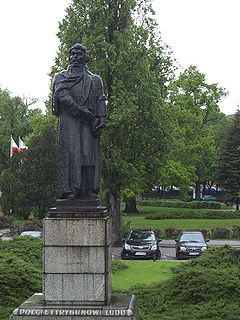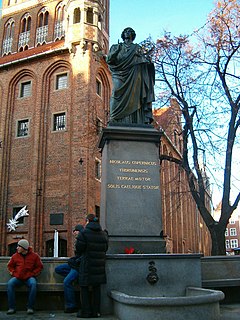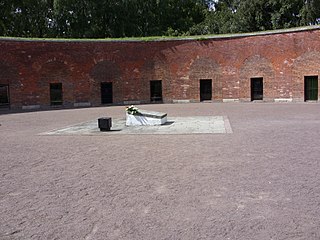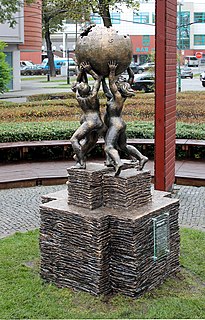 W
WThe Adam Mickiewicz monument in Gorzów Wielkopolski is a notable Gorzów Wielkopolski statue, located near a cross of Lwów Eaglets Street and Władysław Sikorski Street. The monument was designed by Józef Gosławski.\
 W
WThe world's first Bismarck tower was erected by private initiative in 1869 in the village of Ober-Johnsdorf, Silesia, then part of Prussia. It stands on top of the hill now called Jańska Góra, 253 m above sea level. The tower itself is 23 m in height.
 W
WThe Bismarck Tower in Zielona Góra, Poland is one of the best-preserved Bismarck towers outside of present-day Germany. It is also called the Wilkanowska Tower, after the hill on which it stands.
 W
WBolesław III the Wrymouthed Monument in Płock shows prince Bolesław III Wrymouth on horseback, surrounded by a group of warriors walking with banners.
 W
WThe Central Cemetery in Szczecin is a municipal cemetery in Szczecin, Poland. With an area of over 167.8 hectares, and still expanding, it is officially the largest cemetery in Poland and the third largest cemetery in Europe.
 W
WThe Frédéric Chopin monument at Żelazowa Wola is a notable Żelazowa Wola statue, located in a park adjacent to Chopin's birth house.
 W
WChrist the King is a statue of Jesus Christ in Świebodzin, western Poland, completed on 6 November 2010. The figure is 33 metres (108 ft) tall, the crown is 3 metres (9.8 ft) tall, and along with its mound, it reaches 52.5 metres (172 ft) overall. It took five years in total to construct and cost around $1.5 million to build, which was collected from donations of the 21,000 residents of the town. The project was conceived and led by Sylwester Zawadzki, a retired Polish priest. It is the tallest statue of Jesus in the world.
 W
WThe Frederic Chopin Monument in Warsaw is a large bronze statue of Frédéric Chopin (1810–1849) that now stands in the upper part of Warsaw's Royal Baths Park, adjacent to Aleje Ujazdowskie.
 W
WFreedom Monument is a monument in Bydgoszcz commemorating both the fallen Soviet and Polish soldiers who fought during the liberation of the city in January 1945, and the return of Bydgoszcz to Poland on 20 January 1920.
 W
WThe Gate No 2 of the Gdańsk Shipyard is one of the gates leading into Gdańsk Shipyard. Because of the gate's proximity to the Shipyard's management buildings as well as its good access to Gdańsk Main City and Gdańsk Główny railway station, the Gate is commonly considered to be the main entrance to the Shipyard.
 W
WHomo Homini is the first monument in Europe to commemorate the victims of the September 11 attacks in the United States. It is located in Kielce in Poland. The monument was designed by Adam Myjak and was unveiled on September 11, 2006, on the fifth anniversary of the attacks. During the opening ceremony, George W. Bush's letter to citizens of Kielce was read out, and students from Kielce schools lit up grave candles. Each grave candle was inscribed with information, giving a single victim's name and occupation.
 W
WThe Józef Piłsudski monument in Turek is a notable Turek statue, located in The Żermina Składkowska's Park. The monument was designed by Józef Gosławski, during artist's stay in Italy. The monument was designed for the competition organized by Adam Mickiewicz Association in Rome in 1936. The cast of this sculpture was ordered by municipalities of Turek and it is located in the city since 1990.
 W
WJulian Tuwim Monument or the Tuwim's Bench is a monument dedicated to Julian Tuwim at the Piotrkowska Street district of Łódź, Poland. The monument was constructed in 1998-1999 by sculptor Wojciech Gryniewicz.
 W
WMajdanek was a Nazi concentration and extermination camp built and operated by the SS on the outskirts of the city of Lublin during the German occupation of Poland in World War II. It had seven gas chambers, two wooden gallows, and some 227 structures in all, placing it among the largest of Nazi-run concentration camps. Although initially intended for forced labor rather than extermination, the camp was used to kill people on an industrial scale during Operation Reinhard, the German plan to murder all Jews within their own General Government territory of Poland. The camp, which operated from October 1, 1941, until July 22, 1944, was captured nearly intact, because the rapid advance of the Soviet Red Army during Operation Bagration prevented the SS from destroying most of its infrastructure, and the inept Deputy Camp Commandant Anton Thernes failed in his task of removing incriminating evidence of war crimes.
 W
WThe Majdanek State Museum is a memorial museum and education centre founded in the fall of 1944 on the grounds of the Nazi Germany Majdanek death camp located in Lublin, Poland. It was the first museum of its kind in the world, devoted entirely to the memory of atrocities committed in the network of slave-labor camps and subcamps of KL Lublin during World War II. The museum performs several tasks including scholarly research into the Holocaust in Poland. It houses a permanent collection of rare artifacts, archival photographs, and testimony.
 W
WThe Sobibór Museum or the Museum of the Former Sobibór Nazi Death Camp, is a Polish state-owned museum devoted to memorializing the victims and atrocities committed at the former Sobibor extermination camp, located on the outskirts of Sobibór near Lublin. The Nazi German death camp was set up in occupied Poland during World War II, as part of the Jewish extermination program known as the Operation Reinhard, which marked the most deadly phase of the Holocaust in Poland. The camp was run by the SS Sonderkommando Sobibor, initially commanded by Franz Stangl. The number of Jews from Poland and elsewhere who were gassed and cremated there between April 1942 and October 14, 1943 is estimated at 250,000; possibly more, including those who were transported from other Reich-occupied countries.
 W
WThe Maria Konopnicka Monument in Września is a bronze statue located in the town of Września, Greater Poland Region, and dedicated to Maria Konopnicka (1842–1910), a Polish poet, novelist, children's writer and activist for women's rights and for Polish independence.
 W
WThe monument commemorates the necropolis which no longer exists in the city of Gdańsk, Poland.
 W
WMonument of Sokołowo - a monument commemorating the victims of the Battle of Sokołowo on May 2, 1848 during the Greater Poland Uprising. In the battle the forces of the Prussian led by Gen. A. Hirschfeld were against the Polish insurgents who were helped by local peasants and their leader was Ludwik Mierosławski. The victorious battle more than 300 insurgents were killed. This event also marks the Song of 1848. The monument was built according to Cyprian Norwid's idea.
 W
WThe Monument to the fallen Shipyard Workers 1970 was unveiled on 16 December 1980 near the entrance to what was then the Lenin Shipyard in Gdańsk, Poland. It commemorates the 42 or more people killed during the Coastal cities events in December 1970. It was created in the aftermath of the Gdańsk Agreement and is the first monument to the victims of communist oppression to be erected in a communist country. It was designed by: Bogdan Pietruszka, Wiesław Szyślak, Wojciech Mokwiński and Jacek Krenz.
 W
WMonument to the guerrilla fighters of the Mordechai Anielewicz Unit of the People's Guard in Warsaw - a monument located in the Jewish cemetery on Okopowa Street in Warsaw, commemorating the Warsaw Ghetto insurgents who were executed in Krawcowizna by the Germans.
 W
WMonument to World War II Orthodox victims in Białystok is a privately funded memorial commemorating the memory of 5,000 Orthodox Christians from the Białystok region who perished in World War II as well as, during the postwar repressions in Stalinist Poland.
 W
WThe "Never war" monument is an antiwar statue located in Luboń, Poland, on the site of a former German internment camp known as Żabikowo. The monument was designed and built by Józef Gosławski in 1955, using granite and sandstone. It was unveiled 4 November 1956 by General Zygmunt Berling.
 W
WThe Nicolaus Copernicus Monument in Kraków is a notable landmark of Kraków, Poland. It memorializes the astronomer Copernicus, who studied at the Kraków Academy and whose father came from that city, then the capital of Poland.
 W
WThe Nicolaus Copernicus Monument in the home town of astronomer Nicolaus Copernicus (1473–1543) was erected in 1853 by a "monument committee" of the city's residents.
 W
WManor house in Podstolice - historic manor house in Podstolice, in Września Country, in Greater Poland.
 W
WThe Pranger of Poznań is found near the north-east corner of the Town Hall, not far from the Prozerpina Fountain. It is an eight-sided, late-Gothic column, on the summit of which stands a statue of an executioner in a Crusader's outfit holding a raised sword. The current pranger is a copy made by Marcin Rożek in 1925. The original is in the Museum of History of Poznań in the town hall. The pranger was constructed in 1535, financed by fines extracted from workers who wore too-elaborate outfits. The pranger was used to exact punishment through flagellation or the removal of ears or fingers.
 W
WRadogoszcz station is a historic railway station in Łódź, Poland. The station, which was originally built between 1926 and 1937, was used extensively during The Holocaust. It served as the Umschlagplatz for transporting Jews from the Łódź Ghetto to the extermination camps during Operation Reinhard. The "loading platform" is in Marysin, a neighbourhood in the city's Bałuty district.
 W
WThe Rotunda Zamość or the Museum of Martyrdom of the Zamość region - Rotunda, is a Polish museum devoted to remembering the atrocities committed at the former Rotunda Zamość Nazi German camp located in Zamość near Lublin. The Nazi German Gestapo camp was set up in occupied Poland during World War II, as part of the Polish extermination program known as the German AB-Aktion in Poland, Ethnic cleansing of Zamojszczyzna by Nazi Germany....
 W
WThe Silesian Insurgents' Monument in Katowice, southern Poland, is a monument to those who took part in the three Silesian Uprisings of 1919, 1920 and 1921, which aimed to make the region of Upper Silesia part of the newly independent Polish state. The monument was unveiled on 1 September 1967, and was designed by sculptor Gustaw Zemła and architect Wojciech Zabłocki. The wings symbolize the three uprisings, and the names of places where battles were fought are etched on the vertical slopes. The monument was funded by the people of Warsaw for Upper Silesia.
 W
WSt. Florian's Gate or Florian Gate in Kraków, Poland, is one of the best-known Polish Gothic towers, and a focal point of Kraków's Old Town. It was built about the 14th century as a rectangular Gothic tower of "wild stone", part of the city fortifications against Turkish attack.
 W
WOne of the many Bismarck towers built in the former German Empire (Kaiserreich) is located in Szczecin (Gocław), now in north-western Poland.
 W
WThe Wikipedia Monument, located in Słubice, Poland, is a statue designed by Armenian sculptor Mihran Hakobyan honoring Wikipedia contributors. It was unveiled in Frankfurt Square on 22 October 2014 in a ceremony that included representatives from both local Wikimedia chapters and the Wikimedia Foundation.
 W
WThe District office, Września is the office building in which administrative functions for Września County are carried out. It is located south of the town's market (Rynek), on Chopin Street. During the Partitions of Poland, the building was called the "landratura", and the adjacent starost's villa was referred to as the Landrat's villa, as Września was then part of the Kingdom of Prussia.